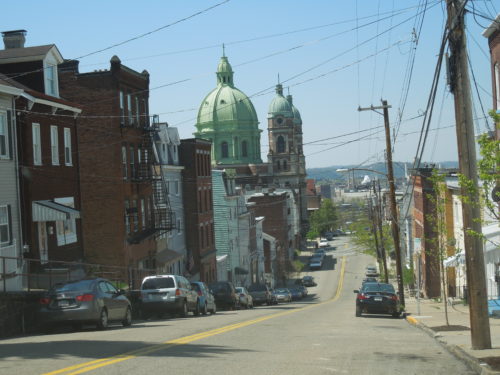
Witamy! Pittsburgh’s Polish Power
February 11, 2015
Greeks in Pittsburgh
February 11, 2015 When Slovakian immigrants came to the United States it was common for them to name settlements after their native land. That’s why we have places called New England, New Mexico, New Jersey, and New York. States and regions weren’t the only things to be named in such a manner. There are numerous towns, villages, and cities with names reflecting the areas from where its residents originated. Pittsburgh has so many people of Slovakian descent. It’s a wonder the city was never called New Slovakia.
When Slovakian immigrants came to the United States it was common for them to name settlements after their native land. That’s why we have places called New England, New Mexico, New Jersey, and New York. States and regions weren’t the only things to be named in such a manner. There are numerous towns, villages, and cities with names reflecting the areas from where its residents originated. Pittsburgh has so many people of Slovakian descent. It’s a wonder the city was never called New Slovakia.
Where is Slovakia
Not everyone knows precisely where Slovakia is located. That’s understandable due to the fact that the area has been a part of other empires over the years. For many years this central European landlocked area has been part of Great Moravia, The Kingdom of Hungary, the Hapsburg Empire or, most recently, the country of Czechoslovakia. Presently, the homeland of the Slovaks is an independent country called The Slovak Republic. Their region has been under the umbrella of many other names. However, those of Slovak heritage have never lost their unique identity. The nation is only two-thirds the size of England.
This country has had a huge impact on the Pittsburgh area. Perhaps because no other region of the United States has more Slovakians than the Pittsburgh area. According to the 2000 U.S. Census, of the nearly 800,000 U.S. citizens claiming Slovak ancestry, the highest percentage of those, around 30.5 %, live in Pennsylvania. The Pittsburgh area has more than 100,000 residents who reported full or partial Slovak heritage, making Pittsburgh the No. 1 city in the world for the most Slovaks outside of Slovakia. It is the fifth-largest heritage group in Pittsburgh. Beaten by the Germans, Italians, Irish, and Polish.
Freedom and Fortune
Like many, Slovaks came to the area for freedom and to find their fortune. Slovakian immigrants did not arrive in a small trickle but as a welcome flood to the city. The first wave of Slovak immigration began in the 1890’s and lasted until the early years of the twentieth century. The peak year for immigration was 1905, with 52,368 immigrants entering the U.S. Approximately 20 percent of the Slovakia population fled due to poverty, disease, and crop failures.
Under Hungarian rule at the time Slovaks were oppressed under a program called Magyarization. Its goal was to strip them of their language and culture. They left their homeland to seek work in the mills and coal mines of Western Pennsylvania. The Slovak immigrants constructed numerous churches in the area. In fact, in 1920 there were 28 Catholic Slovak churches in the region. Many of which had schools and social halls. While smaller in number, Lutheran Slovaks and Byzantine and Greek Catholics from Slovakia also established churches.
Slovakia’s history is a conflicted one. They had periods of independence. Often interrupted by invasion, suppression or annexation. Even this tumultuous past has a Pittsburgh connection. In 1918, The Pittsburgh Agreement was signed at a meeting of the American branch of the Czechoslovak National Council in Pittsburgh. The agreement supported a common state of Czechoslovakia. Which was a democratic republic in which Slovakia would enjoy its own administration, legislation and courts. This accord lasted until the Nazis rose to power. Slovakia was then set up as an independent state. However, in 1945, it was reincorporated into Czechoslovakia. This prompted a smaller wave of immigration to the U.S. This time the influx was not from laborers but from the country’s scholarly class. The invasion of the country in 1968 by the Soviet Union caused an inpour of citizens seeking asylum in the U.S.
National Slovak Society
To survive in their new homeland while retaining their heritage many institutions to help them adapt to their new life were established. In 1890, the National Slovak Society of the United States was founded. It was in Walther’s Hall in Allegheny City, what is now Pittsburgh’s North Side. Its mission was to provide financial security through life insurance and annuity products while at the same time offering “charitable, cultural, social, and educational opportunities” to benefit its members and the community. More than 120 years later, the National Slovak Society is still thriving. It is headquarters are in McMurray, Pennsylvania.
Culture
There are so many residents in Pittsburgh of Slovak descent, that the Slovak Embassy established an Honorary Consulate here in Pittsburgh in 1997. The Honorary Consul, Joseph Senko, formed a non-profit organization. It is the Western Pennsylvania Slovak Cultural Association which showcases Slovak cultural programs to educate the Slovak-Americans and the public. It regularly holds meetings at the Mt. Lebanon Public Library and features cultural programs and Slovak language classes.
The Pittsburgh Area Slovak Folk Ensemble was formed in 1974 to promote the traditional folk music, song, and dance of Slovakia. The ensemble has performed for decades all over the region and country. They have even performed in folk festivals in Slovakia.
The University of Pittsburgh’s Slovak Studies Program illustrates the deep bond between Pittsburgh and Slovakia. Pitt is the only university in the nation that offers a Minor in Slovak Studies. Students can take Slovak language classes and classes in Slovakian culture. In addition the Slovak Studies Program and the university’s Student Slovak Club have hosted a Slovak Heritage Festival. It is open to the public and helps those of Slovak descent to reconnect with their heritage through music, lectures, and food. However, you don’t have to be Slovakian to love haluski (fried noodles and cabbage), holupki (stuffed cabbage) and desserts such as kolache (fruit-filled pastries).
Had Slovakians not come to the Pittsburgh area, our city certainly would not be the same.





